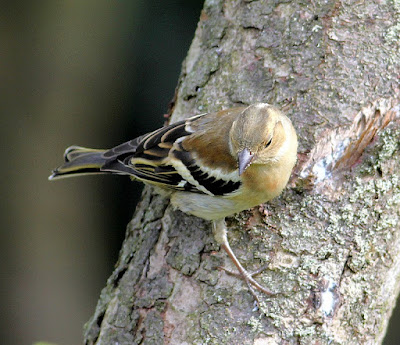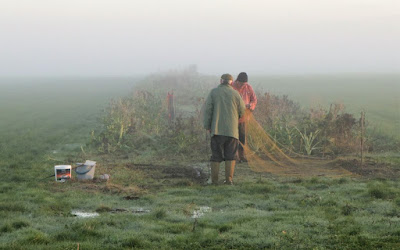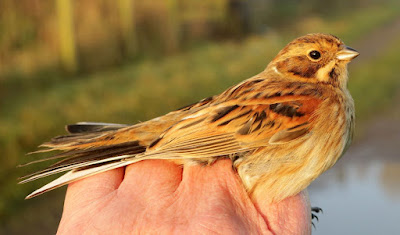The forecasts for Wednesday proved to be on the wrong side of marginal. Luckily I’d already decided to drive and top up the feeding station without taking the ringing gear.
The Fiat splashed through deep puddles of the days and weeks before as I looked for a less sticky spot to park up and disembark.
I’d made a good decision as the wind was a tad strong for any netting and this would be a day for dropping a bucketful of supplementary seed and a quick look around.
A Cetti’s Warbler greeted me with a burst of rapid-fire song as if it was trying to attract attention but I didn’t even look from where the song came because I knew the chances of seeing the bird were close to zero. And anyway, a few seconds later it would be gone and singing fifty yards away.
Fifteen and more visits to Spain’s Balearic Islands where the Cetti’s is both common and widespread taught me not to waste time in trying to actually see a Cetti’s but to instead enjoy its song and eccentric behaviour. While morning and evening can be best, the colour, size and the habitat a Cetti’s chooses makes for challenging birding.
It’s no different here in the UK where hardly anyone sees the skulking, evasive Cetti’s Warbler, a little bird with one of the UK’s loudest and most distinctive songs. It’s thought that by hiding away and singing loudly and forcefully from different parts of its territory, a Cetti's can fool rivals into thinking there are several males present, making the interlopers less likely to stick around. This behaviour allows a male to then have two or three females in his territory and thereby increase the success of his own lineage.
Chaffinches, Reed Buntings, Long-tailed Tits and Greenfinches criss-crossed the net ride in search of the scattered seed. I watched for a while and then dropped seed on the whoosh netting square where the cleared and flattened ground held puddles formed by the days and weeks of rain. A couple of days of wind and sun would dry the square - if only.
Long-tailed Tit
Reed Bunting
Chaffinch
It was Saturday before the wind and rain presented a real window of opportunity by way of a 5mph wind or less across a number of forecasts. It was time to have another go. I met up with Andy and Will at 0700 where the partly flooded farm track glinted in our combined headlights. There was mist which hung around until the sun burnt it off around 10am.
With a little drainage work we made the whoosh net area usable if a little muddy, dropped more seed, set the single panel net to one side of the flooded walkway and erected three nets in the woodland edge.
The morning began, the mist refused to clear, but eventually it did and the catch improved a little. We finished at 1130 with a nice and varied catch of 25 birds - 7 Chaffinch, 5 Linnet, 4 Meadow Pipit, 3 Redwing, 2 Reed Bunting, 1 Greenfinch, 1 Wren, 1 Robin, 1 Blackbird.
Meadow Pipit
Reed Bunting
Greenfinch
Linnet
Redwing
Redwing
Today was one of the better Chaffinch days, yet another farmland
species that is seeing a serious decline in its population. One of the males
today, with a wing length of 95mm, was possibly of Northern European origin, a
type we are seeing less of in recent years. Our UK Chaffinches are generally smaller,
both males and females.
Chaffinch
A good morning was had by all and we'll be back another day on Another Bird Blog.
Linking today to Eileen's Blogspot and Anni in Texas













Hello Phil,
ReplyDeleteWe have had a few of the bad weather days for birding. You did manage to find some beauties. I love that cute Cetti's Warbler. The Long-tailed Tit is a pretty bird and the Chaffinch and Greenfinch are favorites too. Great collection of photos and birds. Thank you for linking up and sharing your post. Take care, have a happy weekend.
I'm so glad you found a morning of better conditions. I guess it will be changing every day now with winter weather on the way. Love the little Cetti's Warbler. What a cutie! Happy weekend!
ReplyDeleteHello Phil, :=)
ReplyDeleteYour photos are all wonderful. The heavy mist looks most unpleasant although the mornings catch was quite fruitful with much better Redwing photos than I posted on my blog. The day before, when the weather conditions were not at all favourable for netting birds, you at least caught some beauties on camera. The Cetti's Warbler and Long tailed Tit are lovely little birds, and I haven't seen a female Chaffinch in a long time, so thank you for this array of gorgeous birds.
Enjoy your weekend
All the best.
Dear Phil,
ReplyDeletefascinating and very sophisticated, these Cetti's Warblers :-D
Your close-up bird shots are great again!
All the best and have a nice weekend,
Traude
https://rostrose.blogspot.com/2022/11/internationale-glastage-in-der.html
A difficult week for you weatherwise so to ring 25 sounds a success. I like the photo showing the mist and early morning light.
ReplyDeleteI'm glad that you got some weather that was a bit better. I love the Chaffinch.
ReplyDeleteSweet birds! I admire your determination.
ReplyDeleteThat warbler is absolutely stunning!!
ReplyDeleteYou all eventually had good numbers, which is a happy ending. Our weather has been wet, cold, windy & dreary. I'm happy to know that. Birding on hold these days, not so good weather has me thinking I'm not missing out.
Terrific post as usual. I always enjoy stopping by for a visit. Thank you for linking in.
If we never had any poor weather, we would not get so excited about the good days. (Okay, that sounds silly now that I read it aloud. Just ignore my meteorological wisdom.)
ReplyDeleteAt least your Saturday improved over your Wednesday. I empathize with you about finding "less sticky" spots to park. Perhaps the lingering mist helped improve your net results?
The Cetti's Warbler fits the description of what we refer to as LBJ's (little brown jobs). They are drab in appearance, prefer to lurk in the underbrush and defy all attempts to obtain a photograph. At least it has a distinctive song.
We're dealing with our own foul weather. The past few days have been rainy, windy and chilly (for us).
It shall pass. We will soon be enjoying crisp mornings with blue skies and birds on every branch. And then we will wake up.
Gini and I hope your new week brings better weather and great ringing!
I have not even heard of a Cetti's Warbler!!! I see that we do get them here but I suspect if I had of spotted one, it would have ended up as an LBJ!!! I must try harder.
ReplyDeleteLove that closeup of the redwing, lovely shot. I never realised how pretty they are
Constant rain here and pretty depressing at the moment! Take care, keep warm and keep dry! Cheers Diane
I think I just fell in love with a long-tailed tit! What a cute bird!
ReplyDeleteThanks for sharing at https://image-in-ing.blogspot.com/2022/11/some-things-im-thankful-for_098575593.html
That warbler is a stunner!
ReplyDeleteFascinating post as always, Phil 👍👍
I'm sure I had commented on this post!
ReplyDeleteI wonder if it may be in spam folder ... blogger is still causing glitches from time to time.
All the best Jan
We sure had snow in Ontario, Phil. We call it snomageddon 2022. My friends in central Ontario, Muskoka, had a metre in two days.
ReplyDelete